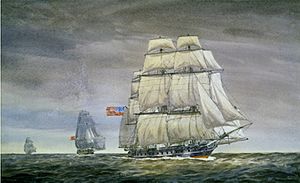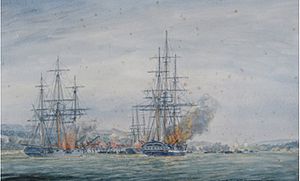USS Adams (1799) facts for kids

The Escape of the Adams, 10 July 1814, by Irwin John Bevan
|
|
Quick facts for kids History |
|
|---|---|
| Name | USS Adams |
| Builder | John Jackson and William Sheffield |
| Cost | $76,622 |
| Laid down | 30 July 1798 |
| Launched | 8 June 1799 |
| Commissioned | 23 September 1799 |
| Fate | Scuttled 3 September 1814 |
| General characteristics | |
| Type | Frigate |
| Tonnage | 530 in June 1812 725 American ton or 783 English ton |
| Length | 113 ft (34 m) 128 ft (39 m) in June 1812 |
| Beam | 34 ft (10 m) |
| Depth | 10 ft 8 in (3.25 m) |
| Complement | 220 officers and men |
| Armament |
|
The USS Adams was a sailing frigate (a type of warship) of the United States Navy. It had 28 guns. The ship was built in New York City starting in 1797. It was launched, meaning put into the water for the first time, on June 8, 1799. Captain Richard Valentine Morris was its first commander.
The ship was named after John Adams, who was one of the Founding Fathers of the United States and the second president of the United States.
Contents
Fighting in the Quasi-War
The Adams left New York in September 1799. It sailed to the West Indies to protect American ships. At this time, the U.S. was in a conflict called the Quasi-War with France. French privateers (private ships allowed to attack enemy shipping) were attacking American merchant ships.
The Adams arrived at Saint Christopher in October. It began looking for French warships and ships they had captured.
Helping Other Ships
Later that month, the Adams recaptured a ship called Zylpha. It also helped another U.S. ship, USS Insurgent, capture a French privateer. They also freed an English ship and a schooner from Boston that the French had taken.
In November, the Adams and Insurgent worked together again. They recaptured the English ship Margaret. A few days later, they captured a French privateer named Le Onze Vendémiaire. They also helped free the schooner Nancy.
More Successes
In January 1800, the Adams and USS Eagle captured the French schooner La Fougeuse. Later that month, the Adams recaptured the schooner Alphia. In February, two more French schooners, L'Heureuse Rencontre and Isabella, were captured.
The Adams freed the ship Nonpareil in March. In April, it did the same for the schooner Priscilla.
May was the most successful month for the Adams. It recaptured an unknown schooner. It also teamed up with Insurgent to free a British ship. During May, the Adams recaptured other ships named Nancy and Grinder. It also captured the ship Dove and the schooner Renommee.
Return to New York
The Adams needed repairs, so it returned to New York in July 1800. In the fall, it sailed back to the Caribbean. Captain Thomas Robinson was now in command. This time, the ship mostly did patrol and escort duties. It did recapture the British schooner Grendin. In March 1801, the Adams was ordered home and stored in New York.
First Barbary War
The Adams did not stay out of service for long. Problems were happening in the Mediterranean Sea. Countries called the Barbary states were capturing American merchant ships. They were also making the crews slaves.
The Adams was made ready for service again in 1802. Captain Hugh George Canfield was its new commander. On June 10, 1802, it left New York. It sailed to the Strait of Gibraltar. The ship carried orders for Commodore Richard V. Morris, who was now in charge of the American fleet there.
The Adams arrived on July 22. It stayed there to block a ship called Meshuda from escaping. This was to stop Meshuda from attacking American ships. The Adams stayed on this duty until April 8, 1803. Then, it joined other ships in operations near Tripoli.
Commodore Morris was not as decisive as a fleet commander. Because of this, he was ordered to return home. He sailed back on the Adams on September 25. The frigate took Morris to Washington, D.C. In November 1803, the Adams was put into storage at the navy yard there.
Years of Peace (1805–1811)
The Adams was reactivated in July 1805. Captain Alexander Murray took command. The ship sailed along the U.S. coast from New York to Florida. Its job was to protect American trade ships.
In the fall of 1806, it was again stored in Washington. It was mostly inactive until the War of 1812 began. In 1809, it did serve to help enforce the Embargo Act. In August 1811, it became a receiving ship at the Washington Navy Yard. This means it was used to house new sailors.
War of 1812
In June 1812, the Adams was rebuilt. It was cut in half and made 15 feet longer. It became a sloop-of-war with 26 guns. Captain Charles Morris commanded the ship. It was ready for action by the end of 1813.
However, British warships blocked the Adams in the Chesapeake Bay. It finally managed to get out to sea on January 18, 1814. It sailed in the eastern Atlantic Ocean and along the African coast. It captured five merchant ships before arriving in Savannah, Georgia, in April.
Final Voyage and Loss
The Adams set sail again in May. It headed for the Newfoundland Banks and then sailed east. It went to waters near the British Isles. During this trip, it captured five more merchant ships. It chased two others into the River Shannon. The Adams barely escaped from a much larger British warship.
It captured a ship called Woodbridge, which was sailing from India to Britain. But the Adams had to give up Woodbridge when HMS Dannemark and HMS Albacore arrived. These British ships were escorting a group of ships to Brazil.
Near the end of its journey home, the Adams hit the ground on the Isle au Haut on August 17, 1814. It was badly damaged. Skilled sailors and a rising tide helped refloat the ship. Even though it was leaking heavily, it made it into the Penobscot River. It reached Hampden, Maine.
There, on September 3, 1814, during the Battle of Hampden, the Adams was scuttled. This means it was sunk on purpose. It was also set on fire. This was done to stop a British fleet from capturing it. The crew mostly escaped and walked overland to Portsmouth, New Hampshire.
See also
- List of sailing frigates of the United States Navy
- Bibliography of early United States naval history


